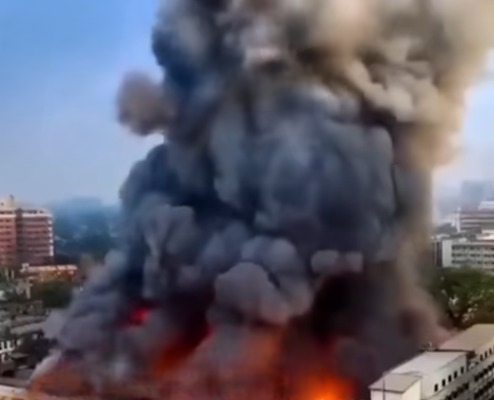🚨BREAKING NEWS🚨Just hours ago, a tremendous fire broke out in…See more.
Strong Earthquake Strikes Border Region — Communities and Authorities Respond Swiftly

In the early hours of Monday morning, residents living near the China–Myanmar border were jolted awake by a powerful earthquake that sent shockwaves across several countries in Southeast Asia. Registering a magnitude of 7.7, the tremor is already being described by seismologists as one of the most forceful quakes the region has endured in recent decades.
The quake struck suddenly, shaking homes, offices, and schools across hundreds of kilometers. People rushed into the streets in fear, while emergency sirens echoed through several towns and cities. Within minutes, both local and national authorities began organizing rapid response efforts to help the affected population.
The Quake’s Epicenter and Reach
According to the United States Geological Survey (USGS), the earthquake originated roughly 10 kilometers beneath the surface — a shallow depth that intensified its destructive potential. The tremors spread widely, reaching southern China, northern Thailand, and several parts of Myanmar.
Residents from urban centers to remote villages reported the ground shifting violently beneath them. In some areas, the movement was described as a rolling wave, while in others, it felt like a sudden violent jolt. The difference in perception highlights how seismic waves travel differently through soil, rock, and mountainous terrain.
Communities closest to the epicenter experienced the most severe shaking. Homes that were not built to withstand such forces suffered significant structural damage. In larger cities farther away, the tremor was still strong enough to cause panic and evacuations.
Immediate Reactions: Fear, Confusion, and Damage
The earthquake struck without warning in the pre-dawn hours, catching many people off guard. Residents, some still in nightclothes, poured into the streets barefoot. Families clutched one another, anxiously watching buildings sway and crack.
Eyewitnesses in northern Thailand described how streetlights flickered and windows shattered. In China’s Yunnan province, apartment blocks shook for nearly a minute, leaving people terrified to return indoors. In Myanmar, villages near the border reported collapsed walls, damaged roads, and widespread power outages.
Critical infrastructure was also impacted. Electricity grids failed in several towns, water lines ruptured, and mobile networks went offline, making it difficult for people to check on loved ones. The breakdown in communication added to the confusion, particularly for families separated across different regions.
Human Toll: Losses and Injuries
Initial reports from local governments confirmed dozens of deaths across the affected regions, with hundreds of injuries. Tragically, some individuals remain trapped beneath collapsed buildings, and rescue teams continue to work tirelessly to reach them.
Hospitals in the hardest-hit areas are overwhelmed. Emergency rooms quickly filled with patients suffering from broken bones, head injuries, and cuts caused by falling debris and shattered glass. Doctors and nurses are working around the clock, while volunteers line up to donate blood and assist with patient care.
Officials caution that the casualty numbers are likely to increase as search-and-rescue missions reach more isolated communities. Many mountain villages are difficult to access due to landslides and damaged roads, which has slowed the arrival of emergency aid.
Rescue Operations Underway
Within hours of the quake, local authorities mobilized first responders, soldiers, and volunteers. Specialized search-and-rescue teams equipped with heavy machinery, sniffer dogs, and thermal imaging cameras began combing through debris.
Their mission is urgent: survival rates for those trapped beneath rubble decrease significantly after the first 48 hours. “Every second counts,” said Dr. Li Wei, a disaster relief coordinator in Yunnan province. “We are focusing on reaching as many people as possible before it is too late.”
Rescue efforts face enormous challenges. Roads are cracked or blocked, bridges are unstable, and continuing aftershocks make the work dangerous. Yet, stories of resilience are emerging: in one case, a child was pulled alive from beneath the remains of a collapsed school, giving hope to anxious families awaiting word about missing relatives.
Impact on Northern Thailand
Northern Thailand also experienced significant shaking. Cities such as Chiang Rai and Chiang Mai reported widespread evacuations. Office workers, students, and hotel guests poured out of buildings as alarms rang. Schools and government offices temporarily suspended operations to allow engineers to assess structural safety.
Transportation was heavily disrupted. Cracks appeared in several highways, and bridges were closed for inspection. Airports in Chiang Mai and Chiang Rai briefly suspended flights while safety checks were conducted. Train services were delayed as tracks were examined for possible warping.
Hospitals treated a surge of injuries, mostly from falling objects or accidents caused by panic. The Thai government dispatched additional medical teams and set up relief centers stocked with food, water, and first-aid kits.
Conditions in China and Myanmar
In southern China, cities closest to the epicenter sustained the most severe structural damage. Older homes and poorly reinforced buildings collapsed entirely. Emergency shelters were established in schoolyards and open fields to provide temporary housing for displaced families.
In Myanmar, rural communities near the border reported heavy losses. Due to limited infrastructure, these areas are particularly vulnerable. Humanitarian organizations are coordinating with local authorities to deliver aid, but blocked roads and communication blackouts are making it difficult to assess the full extent of the situation.
Understanding the Science
A 7.7-magnitude earthquake is classified as a major seismic event capable of widespread destruction. Because the quake occurred at a shallow depth, the seismic energy was concentrated near the Earth’s surface, increasing its impact on structures and people.
The region is geologically active, lying at the intersection of the Eurasian, Indian, and Burma tectonic plates. Over time, stress builds up along fault lines, and when released suddenly, it produces powerful quakes.
Experts note that while earthquakes of this scale are rare in the China–Myanmar border region, history shows the potential for catastrophic events. These geological realities underscore the need for investment in earthquake-resistant construction and improved early warning systems.
Lessons From History
The border region has experienced destructive earthquakes in the past, though few have been as strong as this one. Historical records show that smaller quakes occur regularly, but stronger tremors—though infrequent—pose the greatest threat due to dense populations and vulnerable infrastructure.
Learning from past disasters, authorities have been working to strengthen building codes and expand public awareness campaigns. However, many rural homes remain poorly constructed, leaving communities highly exposed to seismic risks.
Coordinated Response
Authorities are employing a variety of strategies to assist affected residents:
-
Search and Rescue: Crews equipped with advanced technology are locating survivors.
-
Medical Assistance: Hospitals and temporary clinics are providing emergency care.
-
Shelter and Supplies: Relief centers are distributing tents, blankets, food, and clean water.
-
Public Information: Radio, social media, and community leaders are sharing safety updates.
-
Logistical Support: Military and civilian vehicles are transporting aid to remote villages.
International Aid
Given the magnitude of the disaster, international assistance is being mobilized. Neighboring countries have offered support in the form of medical teams, search-and-rescue units, and relief supplies.
Organizations such as the United Nations and the Red Cross have called for swift and coordinated action. “This is a regional crisis that requires solidarity,” said a spokesperson for the Red Cross.
International cooperation will be essential for reaching the hardest-hit communities and ensuring aid is delivered efficiently.
Safety Guidance for Residents
Authorities have urged people in affected regions to remain cautious:
-
Stay outdoors if aftershocks occur.
-
Keep away from damaged buildings and falling debris.
-
Avoid traveling on cracked or obstructed roads.
-
Help vulnerable neighbors, including the elderly and disabled.
-
Stock emergency supplies such as water, food, and medical kits.
Aftershocks are expected to continue in the coming days, and safety officials warn that damaged structures could collapse during subsequent tremors.
Psychological Aftermath
Beyond the visible destruction, earthquakes leave deep emotional scars. Survivors often face anxiety, insomnia, and trauma. Children, in particular, may experience lasting fear after witnessing buildings collapse or losing loved ones.
Mental health specialists are being deployed to provide counseling and support. Community programs, group discussions, and safe play areas for children are among the strategies being used to promote healing and resilience.
The Long Road to Recovery
Rebuilding after such a disaster will take months or even years. Authorities must repair infrastructure, restore utilities, and construct safe housing for those displaced. Economic recovery is another challenge, as businesses and farms have been disrupted.
Governments and aid organizations are expected to conduct comprehensive damage assessments and allocate resources accordingly. Support for small businesses and farmers will be crucial in ensuring livelihoods are restored.
A Global Reminder
This earthquake is a sobering reminder of the importance of disaster preparedness worldwide. Early warning systems, public drills, and earthquake-resistant buildings can dramatically reduce casualties in future events.
Countries located in seismic zones are encouraged to invest in monitoring technology, strengthen building regulations, and run regular awareness campaigns. Sharing knowledge and resources across borders can help create a more resilient global community.
Hope and Resilience Amid Tragedy
Despite the devastation, inspiring stories of courage and solidarity are surfacing. Neighbors are rescuing one another, strangers are donating supplies, and communities are standing united.
“Even in the darkest hours, humanity shines brightest,” said one volunteer working in a relief camp. These acts of compassion demonstrate the resilience of people determined to recover and rebuild.
Conclusion
The 7.7-magnitude earthquake that struck near the China–Myanmar border has left thousands grappling with loss, fear, and uncertainty. Yet, the swift actions of rescue teams, the determination of local communities, and the arrival of international aid highlight the collective will to overcome adversity.
While the coming weeks will test the strength of infrastructure and institutions, they will also showcase the resilience of human spirit. Preparedness, cooperation, and compassion remain the strongest tools in facing natural disasters — not just in Asia, but across the world.



